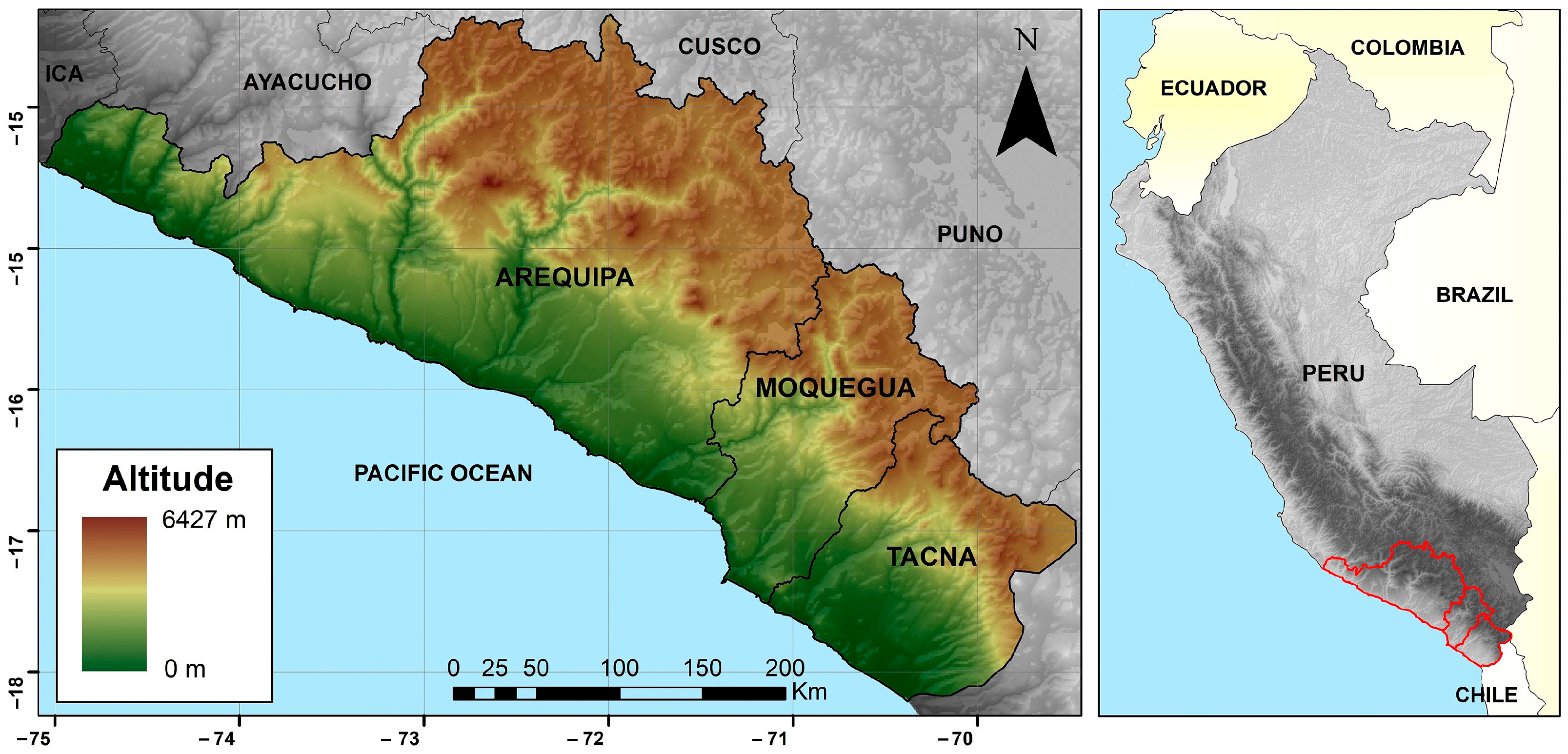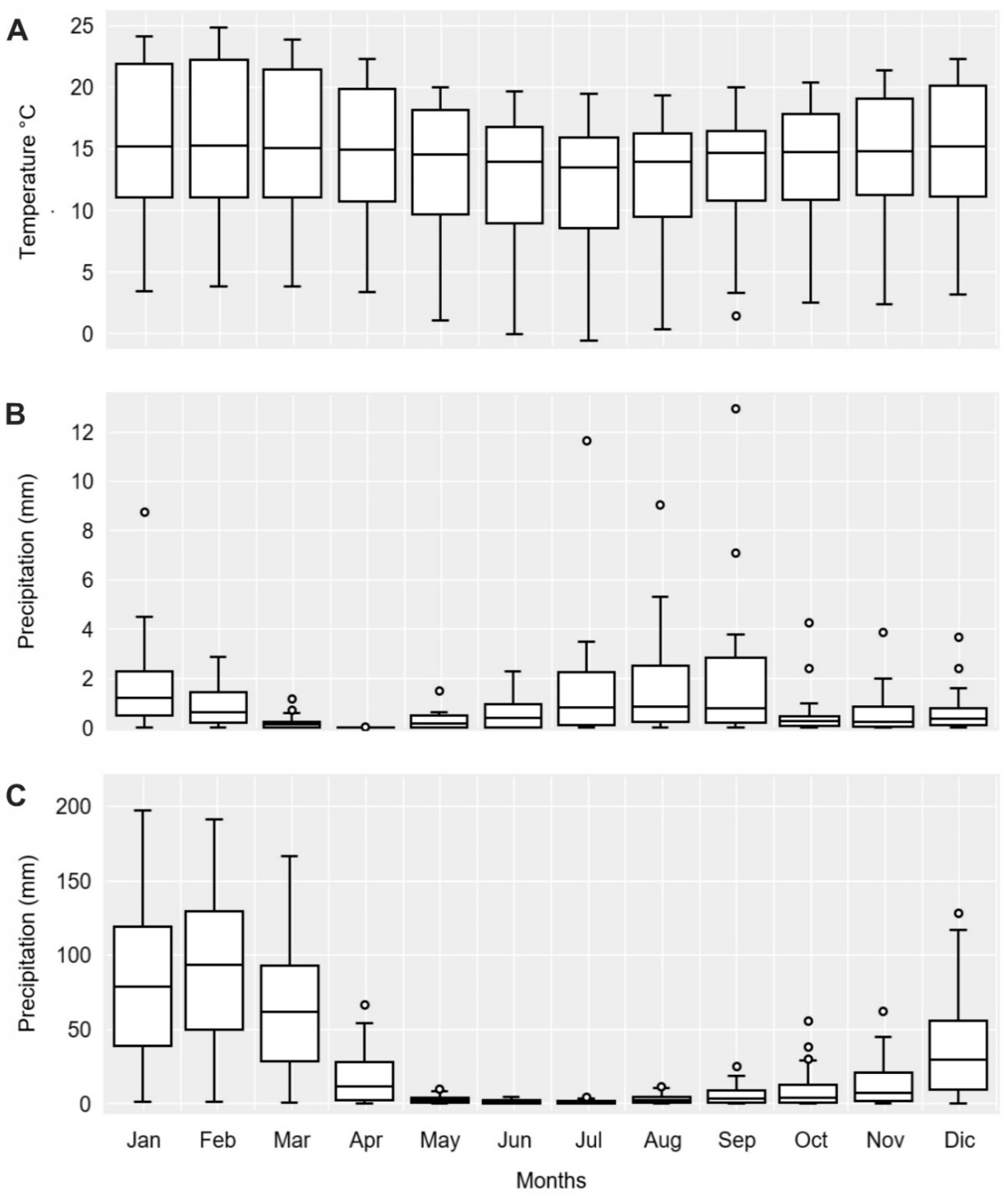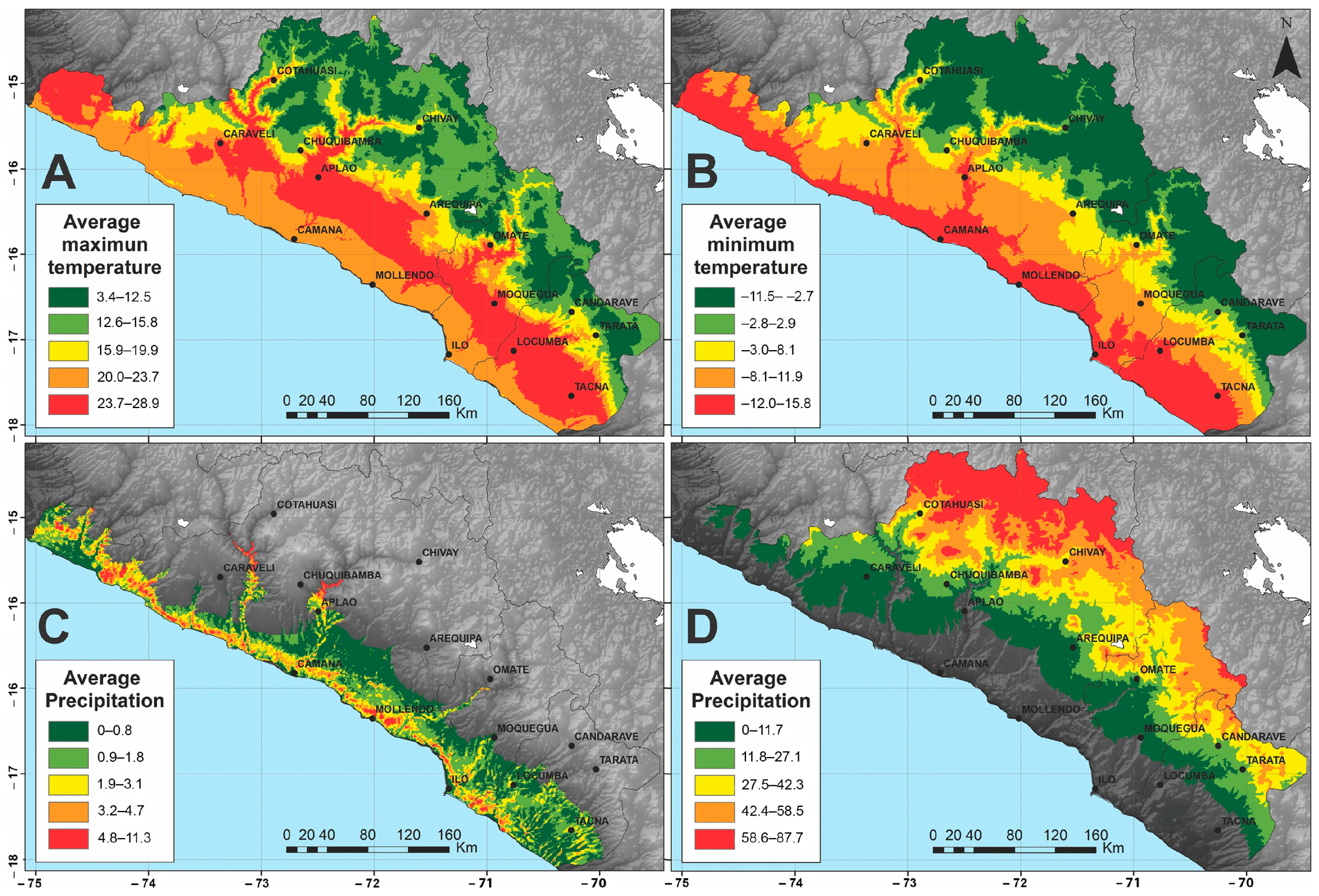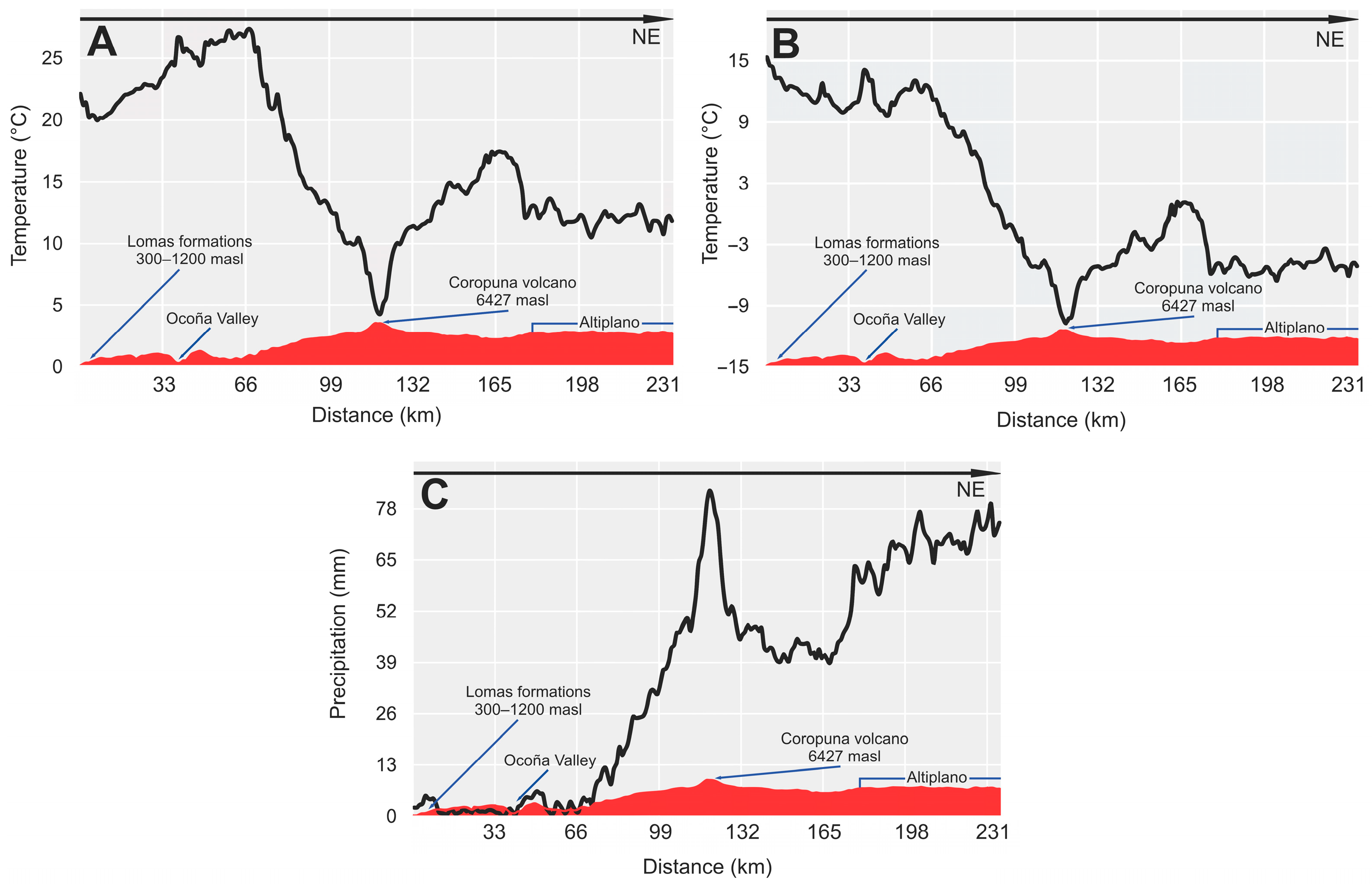High-Resolution Bioclimatic Surfaces for Southern Peru: An Approach to Climate Reality for Biological Conservation
Abstract
:1. Introduction
2. Materials and Methods
2.1. Area of Study
2.2. Collecting Climate Information
- Ppdm = unknown monthly precipitation (mm);
- Pperm = monthly precipitation of the real station (mm);
- NDVIev = NDVI extracted for the virtual station;
- NDVIer = NDVI extracted for the real station.
2.3. Georeferencing Weather Stations
2.4. Treatment of Climate Information
2.5. Covariates, Modeling of Climatic Surfaces and Validation
2.6. Comparison with Other Climatic Surfaces for the Area of Study
2.7. Production of Bioclimatic Layers
3. Results
3.1. Climate Information
3.2. Modeling of Climatic Surfaces
3.3. Validation of Temperature and Precipitation Surfaces
3.4. Comparison with Other Surfaces and Production of Bioclimatic Layers
4. Discussion
4.1. Patterns of the Climatic Information Obtained
4.2. Modeling of Climatic Surfaces and Validation
4.3. Comparison with Other Models Produced for the Area of Study
4.4. Expectations about the Use of Bioclimatic Layers
5. Conclusions
Supplementary Materials
Author Contributions
Funding
Data Availability Statement
Acknowledgments
Conflicts of Interest
References
- Olalla-Tárraga, M.A. Macroecología: Una disciplina de investigación en auge. Ecosistemas 2014, 23, 1–3. [Google Scholar] [CrossRef]
- Araujo, M.B.; Peterson, T. Uses and misuses of bioclimatic envelope modeling. Ecol. Soc. Am. 2012, 92, 1527–1539. [Google Scholar] [CrossRef]
- Title, P.O.; Bemmels, J.B. ENVIREM: An expanded set of bioclimatic and topographic variables increases flexibility and improves performance of ecological niche modeling. Ecography 2018, 41, 291–307. [Google Scholar] [CrossRef]
- Bedia, J.; Herrera, S.; Gutierrez, J.M. Dangers of using global bioclimatic datasets for ecological niche modeling. Limitations for future climate projections. Glob. Planet. Chang. 2013, 107, 1–12. [Google Scholar] [CrossRef]
- Peterson, A.T.; Soberón, J.; Pearson, R.G.; Anderson, R.P.; Martínez-Meyer, E.; Nakamura, M. Ecological niches and geographic distributions. In Monographs in Population Biology, 1st ed.; Levin, S.A., Horn, H.S., Eds.; Princeton University Press: New York, NY, USA, 2011; pp. 1–328. [Google Scholar]
- Li, D.; Lu, X.; Walling, D.E.; Zhang, T.; Steiner, J.F.; Wasson, R.J.; Harrison, S.; Nepal, S.; Nie, Y.; Immerzeel, W.W.; et al. High Mountain Asia hydropower systems threatened by climate-driven landscape instability. Nat. Geosci. 2022, 15, 520–530. [Google Scholar] [CrossRef]
- Yao, T.; Bolch, T.; Chen, D.; Gao, J.; Immerzeel, W.; Piao, S.; Su, F.; Thompson, L.; Wada, Y.; Wang, L.; et al. The imbalance of the Asian water tower. Nat. Rev. Earth Environ. 2022, 3, 618–632. [Google Scholar] [CrossRef]
- Shugar, D.H.; Jacquemart, M.; Shean, D.; Bhushan, S.; Upadhyay, K.; Sattar, A.; Schwanghart, W.; McBride, S.; de Vries, M.V.W.; Mergili, M.; et al. A massive rock and ice avalanche caused the 2021 disaster at Chamoli, Indian Himalaya. Science 2021, 373, 300–306. [Google Scholar] [CrossRef]
- Cook, K.L.; Rekapalli, R.; Dietze, M.; Pilz, M.; Cesca, S.; Rao, N.P.; Srinagesh, D.; Paul, H.; Metz, M.; Mandal, P.; et al. Detection and potential early warning of catastrophic flow events with regional seismic networks. Science 2021, 374, 87–92. [Google Scholar] [CrossRef]
- Fordham, D.A.; Saltré, F.; Haythorne, S.; Wigley, T.M.L.; Otto-Bliesner, B.L.; Chan, K.C.; Brook, B.W. PaleoView: A tool for generating continuous climate projections spanning the last 21,000 years at regional and global scales. Ecography 2017, 40, 1348–1358. [Google Scholar] [CrossRef]
- Otto-Bliesner, B.L.; Marshall, S.J.; Overpeck, J.T.; Miller, G.H.; Hu, A. Simulating Arctic climate warmth and icefield retreat in the last interglaciation. Science 2006, 311, 1751–1753. [Google Scholar] [CrossRef]
- Morin, X.; Thuiller, W. Comparing Niche- and Process-Based Models to Reduce Prediction Uncertainty in Species Range Shifts under Climate Change. Ecology 2009, 90, 1301–1313. [Google Scholar] [CrossRef]
- Hijmans, R.J.; Graham, C.H. The ability of climate envelope models to predict the effect of climate change on species distributions. Glob. Chang. Biol. 2006, 12, 2272–2281. [Google Scholar] [CrossRef]
- Soberón, J.; Peterson, A.T. Interpretation of models of fundamental ecological niches and species’ distributional areas. Biodivers. Inform. 2005, 2, 1–10. [Google Scholar] [CrossRef]
- Araújo, M.B.; Luoto, M. The importance of biotic interactions for modelling species distributions under climate change. Glob. Ecol. Biogeogr. 2007, 16, 743–753. [Google Scholar] [CrossRef]
- Téllez-Valdés, O.; Hutchinson, M.A.; Nix, H.A.; Jones, P. Desarrollo de coberturas digitales climáticas para México. In Cambio Climático. Aproximaciones Para el Estudio de su Efecto en la Biodiversidad, 1st ed.; Sanchez-Rojas, G., Ballesteros, B.C., Pavon, N., Eds.; Universidad Autónoma del Estado de Hidalgo: Hidalgo, Mexico, 2011; pp. 67–70. [Google Scholar]
- Alzate-Velásquez, D.F.; Araujo-Carrillo, G.A.; Rojas-Barbosa, E.O.; Gómez-Latorre, D.A.; Martínez-Maldonado, F.E. Inter-polación Regnie para lluvia y temperatura en las regiones andina, caribe y pacífica de Colombia. Colomb. For. 2018, 21, 102–118. [Google Scholar] [CrossRef]
- Fick, S.E.; Hijmans, R.J. WorldClim 2: New 1km spatial resolution climate surfaces for global land areas. Int. J. Climatol. 2017, 37, 4302–4315. [Google Scholar] [CrossRef]
- Hijmans, R.J.; Cameron, S.E.; Parra, J.L.; Jones, P.G.; Jarvis, A. Very high-resolution interpolated climate surfaces for global land areas. Int. J. Climatol. 2005, 25, 1965–1978. [Google Scholar] [CrossRef]
- De la Casa, A.; Ovando, G. Relación entre la precipitación e índices de vegetación durante el comienzo del ciclo anual de lluvias en la provincia de Córdoba, Argentina. RIA 2006, 35, 67–85. [Google Scholar]
- Mattar, C.; Sobrino, J.A.; Wigneron, J.P.; Jiménez-Muñoz, J.C.; Kerr, Y. Estimación de la humedad del suelo a partir de índices de vegetación y microondas pasivas. Rev. Teledetección 2011, 36, 62–72. [Google Scholar]
- Yarlenque, C.; Posadas, A.; Quiroz, R. Reconstrucción de Datos de Precipitación Pluvial en Series de Tiempo Mediante Trans-Formadas de Wavelet con dos Niveles de Descomposición, 1st ed.; Centro Internacional de la Papa (CIP): Lima, Peru, 2007; pp. 1–15. [Google Scholar]
- Karger, D.N.; Conrad, O.; Böhner, J.; Kawohl, T.; Kreft, H.; Soria-Auza, R.W.; Zimmermann, N.E.; Linder, H.P.; Kessler, M. Climatologies at high resolution for the earth’s land surface areas. Sci. Data 2017, 4, 170122. [Google Scholar] [CrossRef]
- Vega, G.C.; Pertierra, L.R.; Olalla-Tarraga, M.A. MERRAclim, a high-resolution global dataset of remotely sensed bioclimatic variables for ecological modelling. Sci. Data 2017, 4, 170078. [Google Scholar] [CrossRef]
- Amiri, M.; Tarkesh, M.; Jafari, R.; Jetschke, G. Bioclimatic variables from precipitation and temperature records vs. remote sensing-based bioclimatic variables: Which side can perform better in species distribution modeling? Ecol. Inform. 2020, 57, 101060. [Google Scholar] [CrossRef]
- Deblauwe, V.; Droissart, V.; Bose, R.; Sonké, B.; Blach-Overgaard, A.; Svenning, J.C.; Wieringa, J.J.; Ramesh, B.R.; Stévart, T.; Couvreur, T.L.P. Remotely sensed climate data for tropical species distribution models. Glob. Ecol. Biogeogr. 2016, 25, 443–454. [Google Scholar] [CrossRef]
- Lujano, E.; Felipe-Obando, O.; Lujano, A.; Quispe, J. Validación de la precipitación estimada por satélite TRMM y su aplicación en la modelación hidrológica del rio Ramis Puno Perú. Rev. Investig. Altoandin. 2015, 17, 221–228. [Google Scholar] [CrossRef]
- Cuervo-Robayo, A.P.; Téllez-Valdéz, O.; Gómez-Albores, M.A.; Venegas-Barrera, C.S.; Manjarrez, J.; Martínez-Meyer, E. An update of high-resolution monthly climate surfaces for Mexico. Int. J. Climatol. 2013, 34, 2427–2437. [Google Scholar] [CrossRef]
- Zhang, X.; Alexander, L.; Hegerl, G.C.; Jones, P.; Tank, A.K.; Peterson, T.C.; Trewin, B.; Zwiers, F.W. Indices for monitoring changes in extremes based on daily temperature and precipitation data. WIREs Clim. Chang. 2011, 2, 851–870. [Google Scholar] [CrossRef]
- Fernández-Palomino, C.A.; Hattermann, F.F.; Krysanova, V.; Lobanova, A.; Vega-Jácome, F.; Lavado, W.; Santini, W.; Aybar, C.; Bronstert, A. A Novel High-Resolution Gridded Precipitation Dataset for Peruvian and Ecuadorian Watersheds: Development and Hydrological Evaluation. J. Hydrometeorol. 2022, 23, 309–336. [Google Scholar] [CrossRef]
- Aybar, C.; Fernández, C.; Huerta, A.; Lavado, W.; Vega, F.; Felipe-Obando, O. Construction of a high-resolution gridded rainfall dataset for Peru from 1981 to the present day. Hydrol. Sci. J. 2020, 65, 770–785. [Google Scholar] [CrossRef]
- Aybar, C.; Lavado-Casimiro, W.; Huerta, A.; Fernández, C.; Vega, F.; Sabino, E.; Felipe-Obando, O. Uso del Producto Grillado “PISCO” de Precipitación en Estudios, Investigaciones y Sistemas Operacionales de Monitoreo y Pronóstico Hidrometeorológico, 1st ed.; Servicio Nacional de Meteorología e Hidrología del Perú (SENAMHI): Lima, Peru, 2017; pp. 1–22. [Google Scholar]
- Fernandez, M.; Hamilton, H.; Kueppers, L.M. Characterizing uncertainty in species distribution models derived from interpolated weather station data. Ecosphere 2013, 4, 61. [Google Scholar] [CrossRef]
- Soria-Auza, R.W.; Kessler, M.; Bach, K.; Barajas-Barboza, P.; Lehnert, M.; Herzog, S.; Böhner, J. Impact of the quality of climate models for modelling species occurrences in countries with poor climatic documentation: A case study from Bolivia. Ecol. Model. 2010, 221, 1221–1229. [Google Scholar] [CrossRef]
- MINAM (Ministerio del Ambiente). Mapa Nacional de Ecosistemas del Perú, Memoria Descriptiva, 1st ed.; Ministerio del Ambiente: Lima, Peru, 2019; pp. 1–116. [Google Scholar]
- Moat, J.; Orellana-Garcia, A.; Tovar, C.; Arakaki, M.; Arana, C.; Cano, A.; Faundez, L.; Gardner, M.; Hechenleitner, P.; Hepp, J.; et al. Seeing through the clouds—Mapping desert fog oasis ecosystems using 20 years of MODIS imagery over Peru and Chile. Int. J. Appl. Earth Obs. Geoinf. 2021, 103, 102468. [Google Scholar] [CrossRef]
- Didan, K.; Munoz, A.B.; Solano, R.; Huete, A. MODIS Vegetation Index User’s Guide (Collection 6); The University of Arizona: Tuscon, AZ, USA, 2015; p. 31. [Google Scholar]
- QGIS.org. QGIS Geographic Information System. Open-Source Geospatial Foundation Project. 2022. Available online: http://qgis.org (accessed on 10 March 2022).
- Wang, J.; Price, K.P.; Rich, P.M. Spatial patterns of NDVI in response to precipitation and temperature in the central Great Plains. Int. J. Remote Sens. 2001, 22, 3827–3844. [Google Scholar] [CrossRef]
- Schultz, P.A.; Halpert, M.S. Global correlation of temperature, NDVI and precipitation. Adv. Space Res. 1993, 13, 277–280. [Google Scholar] [CrossRef]
- Sotomayor, D.; Jiménez, P. Condiciones meteorológicas y dinámica vegetal del ecosistema costero lomas de Atiquipa (Caravelí—Arequipa) en el sur del Perú. Ecol. Apl. 2008, 7, 1–8. [Google Scholar] [CrossRef]
- Guijarro-Pastor, J.A. Software libre para la depuración y homogeneización de datos climatológicos. In Proceedings of the el Clima, Entre el Mar y la Montaña: Aportaciones Presentadas al IV Congreso de la Asociación Española de Climatología, Santander, Spain, 2–5 November 2004. [Google Scholar]
- Wilson, A.M.; Jetz, W. Remotely Sensed High-Resolution Global Cloud Dynamics for Predicting Ecosystem and Biodiversity Distributions. PLoS Biol. 2016, 14, e1002415. [Google Scholar] [CrossRef]
- Sorensen, R.; Zinko, U.; Seibert, J. On the calculation of the topographic wetness index: Evaluation of different methods based on field observations. Hydrol. Earth Syst. Sci. 2006, 10, 101–112. [Google Scholar] [CrossRef]
- Roa-Lobo, J.; Kamp, U. Uso del índice topográfico de humedad (ITH) para el diagnóstico de la amenaza por desborde fluvial, Trujillo-Venezuela. Rev. Geográfica Venez. 2012, 53, 109–126. [Google Scholar]
- Hutchinson, M.F.; Xu, T. ANUSPLIN Version 4.4 User Guide, 1st ed.; Fenner School of Environment and Society, Australian National University: Canberra, Australia, 2013; pp. 1–55. Available online: http://fennerschool.anu.edu.au/files/anusplin44.pdf (accessed on 10 March 2022).
- RStudio Team. RStudio: Integrated Development for R. RStudio, PBC, Boston. 2020. Available online: http://www.rstudio.com (accessed on 10 March 2022).
- Hijmans, R.J.; Phillips, S.; Leathwick, J.; Elith, J. Dismo: Species Distribution Modeling. In R Package; Version 1.3-9; 2022; Available online: http://CRAN.R-project.org/package=dismo (accessed on 10 March 2022).
- O’Donnell, M.S.; Ignizio, D.A. Bioclimatic Predictors for Supporting Ecological Applications in the Conterminous United States, 1st ed.; U.S. Geological Survey: Reston, VA, USA, 2012; pp. 1–17. [Google Scholar]
- Pauca-Tanco, G.A.; Arias-Enríquez, J.; Quispe-Turpo, J.P. Data from: High-resolution bioclimatic surfaces for southern Peru: An approach to climate reality for biological conservation (1.3) [Data set]. Zenodo 2023. [Google Scholar] [CrossRef]
- Rolland, C. Spatial and Seasonal Variations of Air Temperature Lapse Rates in Alpine Regions. J. Clim. 2003, 16, 1032–1046. [Google Scholar] [CrossRef]
- Dávila, C.; Cubas, F.; Laura, W.; Ita, T.; Porras, P.; Castro, A.; Trebejo, I.; Urbiola, J.; Ávalos, G.; Villena, D.; et al. Atlas de Temperaturas del Aire y Precipitación en el Perú, 1st ed.; Servicio Nacional de Meteorología e Hidrología del Perú (SENAMHI): Lima, Peru, 2021; pp. 1–129. [Google Scholar]
- Hartmann, D.L. Global Physical Climatology, 2nd ed.; Elsevier Science: Oxford, UK, 2016; pp. 1–498. [Google Scholar] [CrossRef]
- Pareja, J. El clima del Perú. Rev. Univ. Católica 1936, 29, 645–655. [Google Scholar]
- Úbeda, J.; Palacios, D. El clima de la vertiente del Pacífico de los Andes Centrales y sus implicaciones geomorfológicas. Espac. Desarro. 2008, 20, 31–56. [Google Scholar]
- Castro, A.; Dávila, C.; Laura, W.; Cubas, F.; Ávalos, G.; López-Ocaña, C.; Villena, D.; Valdez, M.; Urbiola, J.; Trebejo, I.; et al. CLIMAS DEL PERÚ—Mapa de Clasificación Climática Nacional, 1st ed.; Servicio Nacional de Meteorología e Hidrología del Perú (SENAMHI): Lima, Peru, 2021; pp. 1–128. [Google Scholar]
- Reynel, C.; Pennintong, R.T.; Särkinen, T. Cómo se Formó la Diversidad Ecológica del Perú. Fundación Para el Desarrollo Agrario FDA; Centro de Estudios en Dendrología: Lima, Peru, 2013; pp. 1–411. [Google Scholar]
- Aponte-Saravia, J.; Ospina, J.E.; Posada, E. Caracterización y modelamiento espacial de patrones en humedales alto andinos, Perú, mediante algoritmos, periodo 1985–2016. Rev. Geográfica 2017, 158, 149–170. [Google Scholar]
- Mazzarino, M.; Finn, J.T. An NDVI analysis of vegetation trends in an Andean watershed. Wetl. Ecol. Manag. 2016, 24, 623–640. [Google Scholar] [CrossRef]
- Belenguer-Plomer, M.A. Análisis de series temporales de precipitación y vegetación para la detección de anomalías en la producción de alimentos en el Cuerno de África. El caso de Lower Shabelle (Somalia). Rev. Teledetección 2016, 47, 41–50. [Google Scholar] [CrossRef]
- Tiedemann, J.L.; Zerda, H.R. Relación temporal NVDI-precipitación del bosque y pastizal natural de Santiago del Estero, Argentina. Cienc. Investig. For. 2008, 14, 497–507. [Google Scholar] [CrossRef]
- Sanz, E.; Saa-Requejo, A.; Díaz-Ambrona, C.H.; Ruiz-Ramos, M.; Rodríguez, A.; Iglesias, E.; Esteve, P.; Soriano, B.; Tarquis, A.M. Normalized Difference Vegetation Index Temporal Responses to Temperature and Precipitation in Arid Rangelands. Remote Sens. 2021, 3, 840. [Google Scholar] [CrossRef]
- Ichii, K.; Kawabata, A.; Yamaguchi, Y. Global correlation analysis for NDVI and climatic variables and NDVI trends: 1982–1990. Int. J. Remote Sens. 2002, 23, 3873–3878. [Google Scholar] [CrossRef]
- León, T.; Ocola, L.; Rojas, J. Ubicación de la mayor concentración de nieblas de advección en la Costa Central del Perú entre los años 2000–2014, usando imágenes satelitales, como potenciales recursos de agua dulce. Rev. Investig. Física 2020, 23, 54–60. [Google Scholar] [CrossRef]
- Jiménez, P.; Villegas, L.; Villasante, F.; Talavera, C.; Ortega, A. Las Lomas de Atiquipa: Agua en el desierto. In ¿Gratis? los Servicios de la Naturaleza y Como Sostenerlos en el Perú, 1st ed.; Hajek, F., Martínez, P., Eds.; SePerú: Lima, Peru, 2012; pp. 159–170. [Google Scholar]
- Tovar, C.; Sánchez-Infantas, E.; Teixeira-Roth, V. Plant community dynamics of lomas fog oasis of Central Peru after the extreme precipitation caused by the 1997–98 El Niño event. PLoS ONE 2018, 13, e0190572. [Google Scholar] [CrossRef]
- Jiménez, P.; Talavera, C.; Villegas, L.; Huamán, E.; Ortega, A. Condiciones meteorológicas en las lomas de Mejía en “El Niño 1997–98” y su influencia en la vegetación. Rev. Peru. Biol. Vol. Extraordin. 1999, 6, 133–136. [Google Scholar] [CrossRef]
- Dillon, M.O.; Nakazawa, M.; Leiva, S. The Lomas Formations of Coastal Peru: Composition and Biogeographic History. Fieldiana 2003, 48, 1–9. [Google Scholar]
- Karger, D.N.; Wilson, A.M.; Mahony, C.; Zimmermann, N.E.; Jetz, W. Global daily 1 km land surface precipitation based on cloud cover-informed downscaling. Sci. Data 2021, 8, 307. [Google Scholar] [CrossRef]
- Valipour, M.; Dietrich, J. Developing ensemble mean models of satellite remote sensing, climate reanalysis, and land surface models. Theor. Appl. Clim. 2022, 150, 909–926. [Google Scholar] [CrossRef]
- Muhuri, A.; Gascoin, S.; Menzel, L.; Kostadinov, T.S.; Harpold, A.A.; Sanmiguel-Vallelado, A.; Lopez-Moreno, J.I. Performance Assessment of Optical Satellite-Based Operational Snow Cover Monitoring Algorithms in Forested Landscapes. IEEE J. Sel. Top. Appl. Earth Obs. Remote Sens. 2021, 14, 7159–7178. [Google Scholar] [CrossRef]
- Price, D.T.; Mckenney, D.W.; Nalder, I.A.; Hutchinson, M.F.; Kesteven, J.L. A comparison of two statistical methods for spatial interpolation of Canadian monthly mean climate data. Agric. For. Meteorol. 2000, 101, 81–94. [Google Scholar] [CrossRef]
- Hustie, T.; Tibshirani, R.; Friedman, J. The Elements of Statistical Learning. In Data Mining, Inference, and Prediction, 2nd ed.; Springer: New York, NY, USA, 2009. [Google Scholar] [CrossRef]







| Surfaces | January | February | March | April | May | June | July | August | September | October | November | December |
|---|---|---|---|---|---|---|---|---|---|---|---|---|
| Mean (SD) | 18.8 (6.2) | 18.6 (6.0) | 19.1 (6.4) | 18.8 (5.8) | 18.5 (5.6) | 17.8 (5.6) | 17.4 (5.7) | 17.9 (5.3) | 18.4 (5.1) | 19.2 (4.9) | 19.6 (5.1) | 19.3 (5.4) |
| Min V | 2.4 | 2.4 | 3.4 | 3.4 | 3.8 | 2.2 | 1.5 | 3.5 | 3.5 | 4.6 | 5.1 | 5.0 |
| Max V | 31.4 | 32.1 | 31.3 | 30.3 | 27.9 | 27.9 | 27.5 | 28.0 | 29.1 | 29.6 | 29.8 | 30.6 |
| 95% CI | 0.02 | 0.02 | 0.02 | 0.02 | 0.02 | 0.02 | 0.02 | 0.02 | 0.02 | 0.02 | 0.02 | 0.02 |
| Surfaces | January | February | March | April | May | June | July | August | September | October | November | December |
|---|---|---|---|---|---|---|---|---|---|---|---|---|
| Mean (SD) | 7.2 (7.2) | 7.5 (7.2) | 7.0 (7.1) | 5.3 (7.6) | 2.9 (8.4) | 1.7 (8.8) | 1.3 (8.3) | 1.8 (8.3) | 3.2 (6.9) | 3.4 (7.9) | 4.2 (7.8) | 5.5 (7.2) |
| Min V | −9.2 | −8.7 | −7.9 | −11.1 | −13.4 | −16.5 | −15.9 | −15.9 | −12.1 | −12.4 | −11.5 | −9.3 |
| Max V | 19.4 | 19.7 | 19.1 | 17.2 | 15.1 | 14.3 | 14.5 | 13.4 | 12.5 | 14.5 | 16.2 | 16.8 |
| 95% CI | 0.03 | 0.03 | 0.03 | 0.03 | 0.03 | 0.03 | 0.03 | 0.03 | 0.02 | 0.03 | 0.03 | 0.03 |
| Surfaces | January | February | March | April | May | June | July | August | September | October | November | December |
|---|---|---|---|---|---|---|---|---|---|---|---|---|
| Mean (SD) | 65.0 (65.4) | 67.3 (66.2) | 53.2 (55.2) | 16.3 (20.1) | 3.3 (3.4) | 2.2 (1.6) | 2.0 (1.7) | 4.3 (3.4) | 6.5 (6.2) | 9.4 (11.6) | 13.3 (17.1) | 32.0 (36.6) |
| Min V | 0 | 0 | 0 | 0 | 0 | 0 | 0 | 0 | 0 | 0 | 0 | 0 |
| Max V | 219.2 | 222.8 | 190.2 | 80.1 | 16.4 | 8.2 | 12.4 | 16.9 | 27.8 | 60.6 | 75.6 | 142.8 |
| 95% CI | 0.23 | 0.24 | 0.20 | 0.07 | 0.01 | 0.01 | 0.01 | 0.01 | 0.02 | 0.04 | 0.06 | 0.13 |
| Months | Maximum Temperature (°C) | Minimum Temperature (°C) | Precipitation (mm) | |||
|---|---|---|---|---|---|---|
| RMSEcv | MADE | RMSEcv | MADE | RMSEcv | MAD | |
| January | 1.5 | 1.1 | 0.8 | 0.6 | 11.6 | 8.2 |
| February | 1.5 | 1.2 | 0.8 | 0.7 | 12.2 | 8.6 |
| March | 1.5 | 1.1 | 0.8 | 0.6 | 10.1 | 7.0 |
| April | 1.4 | 1.1 | 1.0 | 0.7 | 5.7 | 3.6 |
| May | 1.4 | 1.1 | 1.5 | 1.0 | 1.6 | 1.2 |
| June | 1.4 | 1.1 | 1.7 | 1.2 | 1.3 | 1.0 |
| July | 1.4 | 1.0 | 1.8 | 1.2 | 1.6 | 1.1 |
| August | 1.5 | 1.1 | 1.7 | 1.2 | 2.4 | 1.8 |
| September | 1.7 | 1.2 | 1.4 | 1.1 | 3.5 | 2.7 |
| October | 1.6 | 1.2 | 1.1 | 0.8 | 5.0 | 3.4 |
| November | 1.7 | 1.3 | 1.1 | 0.8 | 5.0 | 3.4 |
| December | 1.6 | 1.2 | 0.9 | 0.7 | 9.2 | 6.1 |
| Average | 1.5 | 1.1 | 1.2 | 0.9 | 5.8 | 4.0 |
| Variables | A | B | C |
|---|---|---|---|
| Coastal Precipitation (mm) | n = 2000 | ||
| Mean (SD) | 18.8 (15.4) | 9.5 (7.7) | 23.2 (15.1) |
| Median (Q1, Q3) | 14.0 (8.0–26.0) | 8.0 (5.0–12.0) | 20.0 (13.0–29.0) |
| Range | 0.0–96.0 | 0.0–62.0 | 2.0–116.0 |
| p value | - | <0.01 * | <0.01 * |
| Andes Precipitation (mm) | n = 2000 | ||
| Mean (SD) | 378.1 (271.3) | 355.4 (254.8) | 302.2 (240.3) |
| Median (Q1, Q3) | 408.0 (118.0–594.0) | 363.5 (94.8–581.3) | 230.0 (109.8–451.0) |
| Range | 0.0–1011.0 | 9.0–873.0 | 14.0–1151.0 |
| p value | - | <0.05 | <0.01 * |
| Temperature (°C) | n = 4000 | ||
| Mean (DS) | 11.43 (6.54) | 11.25 (6.75) | 10.84 (7.22) |
| Median (Q1, Q3) | 12.90 (4.3–17.8) | 12.35 (4.2–18.01) | 10.70 (3.7–17.6) |
| Range | −3.60–21.00 | −6.30–21.10 | −6.40–24.00 |
| p value | - | 0.498 | <0.01 * |
Disclaimer/Publisher’s Note: The statements, opinions and data contained in all publications are solely those of the individual author(s) and contributor(s) and not of MDPI and/or the editor(s). MDPI and/or the editor(s) disclaim responsibility for any injury to people or property resulting from any ideas, methods, instructions or products referred to in the content. |
© 2023 by the authors. Licensee MDPI, Basel, Switzerland. This article is an open access article distributed under the terms and conditions of the Creative Commons Attribution (CC BY) license (https://creativecommons.org/licenses/by/4.0/).
Share and Cite
Pauca-Tanco, G.A.; Arias-Enríquez, J.F.; Quispe-Turpo, J.d.P. High-Resolution Bioclimatic Surfaces for Southern Peru: An Approach to Climate Reality for Biological Conservation. Climate 2023, 11, 96. https://doi.org/10.3390/cli11050096
Pauca-Tanco GA, Arias-Enríquez JF, Quispe-Turpo JdP. High-Resolution Bioclimatic Surfaces for Southern Peru: An Approach to Climate Reality for Biological Conservation. Climate. 2023; 11(5):96. https://doi.org/10.3390/cli11050096
Chicago/Turabian StylePauca-Tanco, Gregory Anthony, Joel Fernando Arias-Enríquez, and Johana del Pilar Quispe-Turpo. 2023. "High-Resolution Bioclimatic Surfaces for Southern Peru: An Approach to Climate Reality for Biological Conservation" Climate 11, no. 5: 96. https://doi.org/10.3390/cli11050096
APA StylePauca-Tanco, G. A., Arias-Enríquez, J. F., & Quispe-Turpo, J. d. P. (2023). High-Resolution Bioclimatic Surfaces for Southern Peru: An Approach to Climate Reality for Biological Conservation. Climate, 11(5), 96. https://doi.org/10.3390/cli11050096






